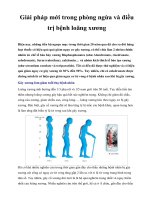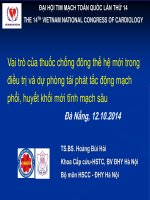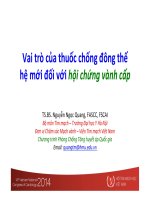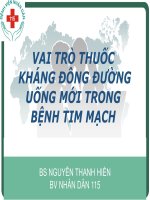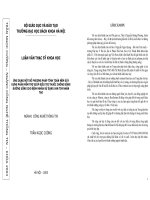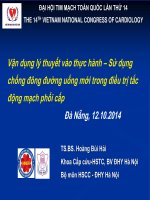VAI TRÒ THUỐC CHỐNG ĐÔNG ĐƯỜNG UỐNG MỚI TRONG PHÒNG NGỪA ĐỘT QUỴ Ở BỆNH NHÂN RUNG NHĨ KHÔNG DO BỆNH VAN TIM
Bạn đang xem bản rút gọn của tài liệu. Xem và tải ngay bản đầy đủ của tài liệu tại đây (3.42 MB, 54 trang )
Ts.Bs. Đinh Hiếu Nhân
Đại Học Y Dược TpHCM
VAI TRÒ THUỐC CHỐNG
ĐƠNG ĐƯỜNG UỐNG
MỚI TRONG PHỊNG
NGỪA ĐỘT QUỴ Ở BỆNH
NHÂN RUNG NHĨ KHÔNG
DO BỆNH VAN TIM
I. TỔNG QUAN
Definitions of AF: A Simplified Scheme
Term
Definition
Paroxysmal AF
AF that terminates spontaneously or with intervention within 7 d of onset.
Episodes may recur with variable frequency.
Persistent AF
Continuous AF that is sustained >7 d.
Long-standing
persistent AF
Continuous AF >12 mo in duration.
Permanent AF
The term “permanent AF” is used when the patient and clinician make a
joint decision to stop further attempts to restore and/or maintain sinus
rhythm.
Acceptance of AF represents a therapeutic attitude on the part of the
patient and clinician rather than an inherent pathophysiological attribute of
AF.
Acceptance of AF may change as symptoms, efficacy of therapeutic
interventions, and patient and clinician preferences evolve.
Nonvalvular AF
AF indicates atrial fibrillation.
AF in the absence of rheumatic mitral stenosis, a mechanical or
bioprosthetic heart valve, or mitral valve repair.
Atrial fibrillation
AF is the most common heart rhythm disturbance1
It is estimated that 1 in 4 individuals aged 40 years will
develop AF1
In 2007, 6.3 million people in the US, Japan, Germany,
Italy, Spain, France, and UK were living with diagnosed
AF2
Owing to the aging population, this number is expected to
double within 30 years3
1. Lloyd-Jones DM et al. Circulation 2004;110:1042-1046.
2. Decision Resources. Atrial Fibrillation Report. Dec 2008.
3. Go AS et al. JAMA. 2001;285:2370-2375.
Seniorprofessur Neurologie UniversitätsKlinikum und Universität Heidelberg
Rationale for Stroke Prevention in AF
AF is associated with a 25% life-time risk of stroke1
Cardio-embolic stroke has a 30-day mortality
of 25% and a 1 year mortality of almost 50%2
Cardio-embolic strokes are more severe and more often
disabling than strokes of other etiology
Once a stroke has happened the risk for subsequent
cardio-embolic stroke is increased 2-3fold
AF-related stroke has a 1-year mortality of ~50%3
1. Wolf PA et al. Stroke. 1991;22:983-988. 2. Lin H-J et al. Stroke. 1996; 27:1760-1764.
3. Marini C et al. Stroke. 2005;36:1115-1119..
Seniorprofessur Neurologie UniversitätsKlinikum und Universität Heidelberg
Anticoagulation in AF: Stroke Risk Reduction
In the past, the most widely used medications for stroke
prevention in patients with AF were vitamin K-antagonists
(VKAs) and aspirin
VKAs are very effective in preventing stroke among
AF- patients
• Almost 70% relative risk reduction vs placebo
Kirchhof P et al. Working Group Report, 2009.
Seniorprofessur Neurologie UniversitätsKlinikum und Universität Heidelberg
Stroke Risk Reduction in AF (Warfarin vs placebo)
AFASAK: Peterson et al
811
Lancet 1989;1:175
BAATAF: Investigators
922
NEJM 1990;323;1505
CAFA: Connolly et al,
478
JACC 1991;18:349
SPAF: Investigators
508
Stroke 1990;21:538
SPINAF: Ezekowitz et al
972
NEJM 1992;327:1406
3691
COMBINED
100%
50%
Warfarin better
0%
–50%
–100%
Warfarin worse
Seniorprofessur Neurologie UniversitätsKlinikum und Universität Heidelberg
Arch Intern Med 1994;154:1449-1457
CHA2DS2-VASc score and stroke risk in AF
Points
CHA2DS2VASc
1-year
stroke rate
Previous stroke
TIA or systemic
embolism
2
9
23.64%
8
22.38%
Age ≥75 years
2
7
21.50%
Congestive heart
failure*
1
6
19.74%
5
15.26%
Hypertension
1
4
9.27%
Diabetes mellitus
1
3
5.92%
Age 65–74 years
1
2
3.71%
Female gender
1
1
2.01%
Vascular disease
1
0
0.78%
Item
Add points
together
*Or moderate-to-severe left ventricular systolic dysfunction (LVEF ≤40%)
Seniorprofessur Neurologie UniversitätsKlinikum und Universität Heidelberg
Olesen JB, et al. BMJ. 2011;342:d124;
Camm AJ, et al. Eur Heart J. 2010;31:2369-2429.
II. ĐIỀU TRỊ
TIẾP CẬN ĐIỀU TRỊ RUNG NHĨ
Overview of AF Management
AF Detected
Management of
Arrhythmia
Assessment of
Thromboembolic Risk
(CHA2DS2-VASc score )
ASA
OAC
Rate
Control
No antithrombotic therapy may be appropriate in selected
young patients with no stroke risk factors
Rhythm
Control
Coagulation Cascade
Intrinsic Pathway
(Contact Activation)
XII
Extrinsic Pathway
(Tissue Factor)
XI
Tissue
Factor
IX
VIII
VKAs
VII
X
Factor Xa Inhibitors (-AT)
Apixaban and Rivaroxaban
V
II
Fibrinogen
Direct Thrombin Inhibitors
Dabigatran
Fibrin Clot
Adapted with
permission from
Nutescu et al.
Anticoagulation in AF: Stroke
Risk Reduction
• In the past, the most widely used medications
for stroke prevention in patients with AF were
vitamin K-antagonists (VKAs) and aspirin
• VKAs are very effective in preventing stroke
among AF- patients
– Almost 70% relative risk reduction vs placebo
Kirchhof P et al. Working Group Report, 2009.
Underutilization of OAKs in Atrial
Fibrillation
Go et al Ann Intern Med 1999
Samsa et al Arch Intern Med 2000
Gage et al Stroke 2000
Waldo et al J Am Coll Cardiol 2005
Nieuwlaat et al Eur Heart J 2006
Hylek et al Stroke 2006
Birman-Deych et al Stroke 2006
Friberg et al Eur Heart J 2006
Monte et al Eur Heart J 2006
Boulanger et al Int J Clin Pract 2006
And When AC Was Given, The TTR Was
Far From Good
“Time in therapeutic range” (TTR) in
daily
Time in therapeutic range (%)
100
80
63
60
51
47
40
56
49
52
55
51
42
36
20
0
Samsa
20002
n = 61
Samsa McCormick Matchar
20002
20013
20034*
n = 125
n = 174 n = 363
Matchar
20034*
n = 317
Matchar
20034*
n = 317
Go
Shen
5
2003
20076
n = 7445 n = 11,016
Nichol
20087*
n = 756
Subtotal†
The 50 /50 Rule
• About 50% of the patients who need VKAOACs don´t get it
•
Of those who get VKA-OACs, 50% are outside the
therapeutic range
75% BN ĐIỀU TRỊ KHÔNG HIỆU QUẢ
HAY KHÔNG ĐIỀU TRỊ.
VKAs have a narrow therapeutic
window
Adjusted odds ratios for ischaemic stroke and intracranial
bleeding in relation to intensity of anticoagulation
Odds ratio for event
20
15
Ischaemic
stroke
10
Intracranial
bleeding
Target
INR
5
1
1.0
2.0
3.0
4.0
5.0
6.0
International normalized ratio
Adapted from Wann et al. Circulation 2011;123;e269-e367
7.0
8.0
Factor Xa Inhibitors And Direct Thrombin
Inhibitors For Stroke Prevention in AF
DTI, direct thrombin inhibitor
Metaanalysis
This meta-analysis is the first to include data for all four
new oral anticoagulants studied in the pivotal phase 3
clinical trials for stroke prevention or systemic embolic
events in patients with atrial fibrillation.
New oral anticoagulants had a favourable risk–benefit
profile, with significant reductions in stroke, intracranial
haemorrhage, and mortality, and with similar major
bleeding as for warfarin, but increased gastrointestinal
bleeding.
Ruff et al Lancet 2014
Seniorprofessur Neurologie UniversitätsKlinikum und Universität Heidelberg
Metaanalysis
Primary endpoint
Ruff et al Lancet 2014
Seniorprofessur Neurologie UniversitätsKlinikum und Universität Heidelberg
Metaanalysis
Ruff et al Lancet 2014
Seniorprofessur Neurologie UniversitätsKlinikum und Universität Heidelberg

